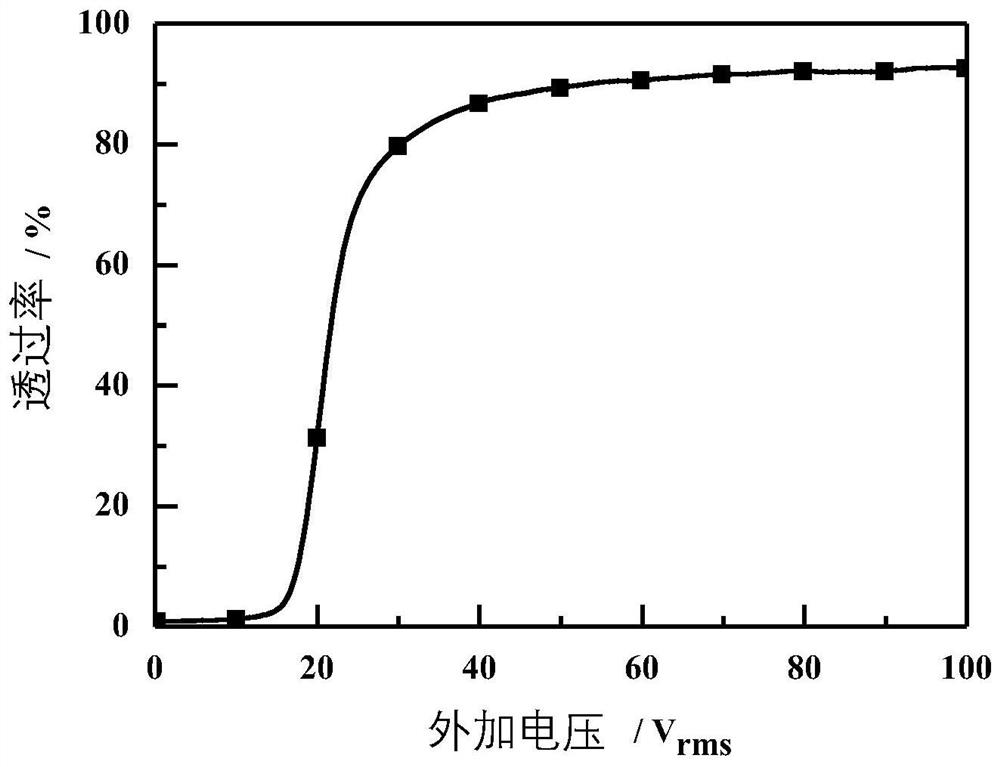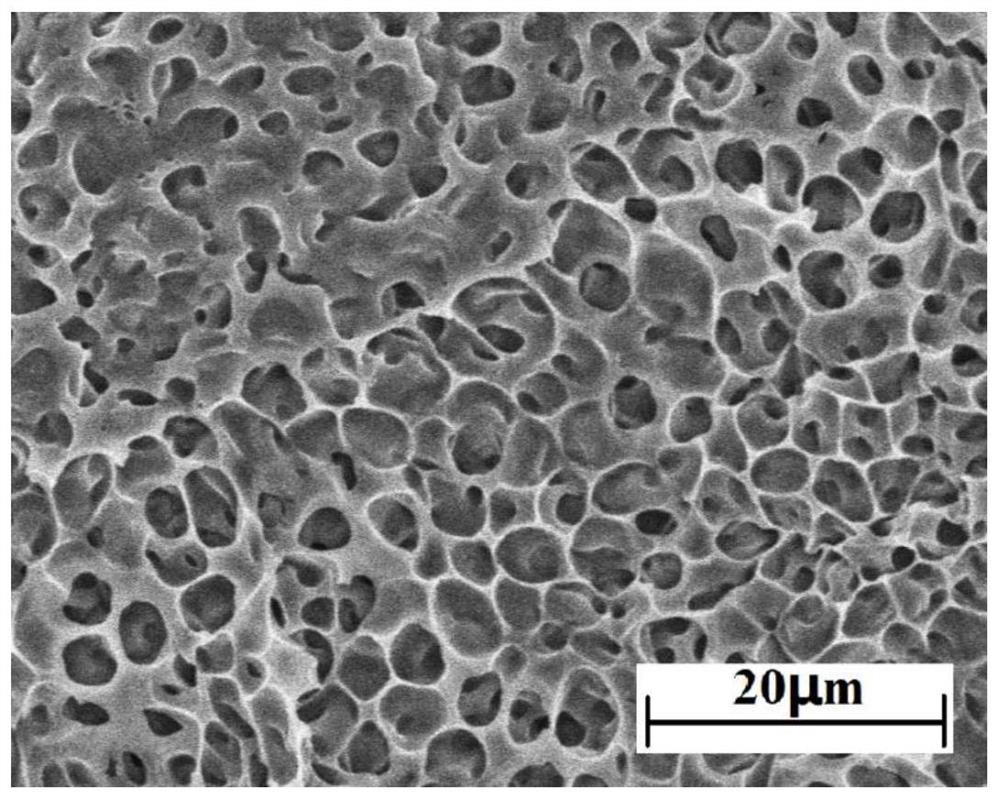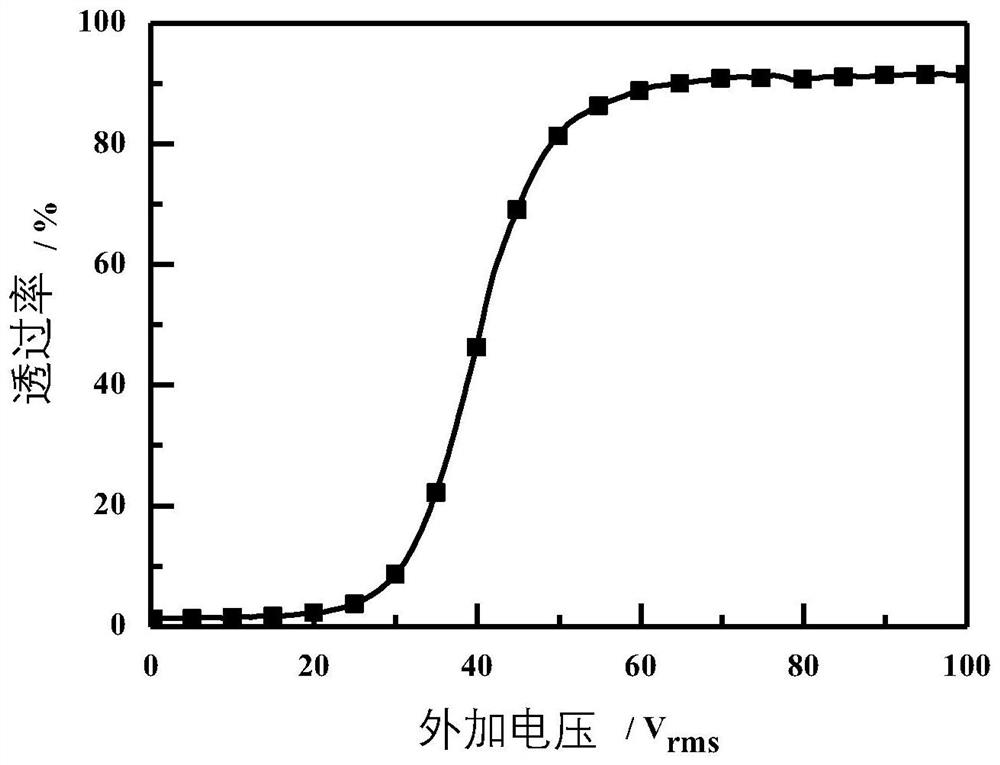A method for preparing polymer dispersed liquid crystal film based on vinyl ether-thiol ultraviolet light curing system
A vinyl ether, disperse liquid crystal technology, applied in chemical instruments and methods, liquid crystal materials and other directions, can solve the problems of difficult environmental pollution, strong irritation, high toxicity, etc., to improve electro-optic performance, low volatility, low toxicity Effect
- Summary
- Abstract
- Description
- Claims
- Application Information
AI Technical Summary
Problems solved by technology
Method used
Image
Examples
Embodiment 1
[0033] The polymerizable monomer and liquid crystal are mixed according to the mass ratio of 3:7, wherein the polymerizable monomer is triethylene glycol divinyl ether and tetrakis (3-mercaptopropionate) pentaerythritol ester, and the molar ratio of double bond and mercapto group is controlled 1:1, and add UV photoinitiator 1173 accounting for 5.0% of the mass of the polymerizable monomer, the liquid crystal material used is nematic liquid crystal SLC 1717 matching the refractive index of the selected polymerizable monomer; stir evenly Finally, pour the mixed system into a liquid crystal cell made of two pieces of conductive glass coated with indium tin oxide (ITO), and control the thickness between the two pieces of ITO conductive glass of the liquid crystal cell to be about 20 μm; at a temperature of 273K , put the filled liquid crystal cell at a wavelength of 365nm and a light intensity of 10mW / cm 2 Under the ultraviolet light, irradiate 10min, promptly obtain the PDLC thin...
Embodiment 2
[0037] The polymerizable monomer and liquid crystal are mixed according to the mass ratio of 6:4, wherein the polymerizable monomer is triethylene glycol divinyl ether and tetrakis (3-mercaptopropionate) pentaerythritol ester, and the molar ratio of double bond and mercapto group is controlled 1:1, and add UV photoinitiator 1173 accounting for 5.0% of the mass of the polymerizable monomer, the liquid crystal material used is nematic liquid crystal SLC 1717 matching the refractive index of the selected polymerizable monomer; stir evenly Finally, pour the mixed system into a liquid crystal cell made of two pieces of conductive glass coated with indium tin oxide (ITO), and control the thickness between the two pieces of ITO conductive glass of the liquid crystal cell to be about 20 μm; at a temperature of 273K , put the filled liquid crystal cell at a wavelength of 365nm and a light intensity of 10mW / cm 2 Under the ultraviolet light, irradiate 10min, promptly obtain the PDLC thin...
Embodiment 3
[0041] The polymerizable monomer and liquid crystal are mixed according to the mass ratio of 3:7, wherein triethylene glycol divinyl ether is selected as the vinyl ether polymerizable monomer, and monomers with different functionalities are selected as the thiol monomer, respectively. For 3,6-dioxa-1,8-octanedithiol, trimethylolpropane tris(3-mercaptopropionate) and inositol hexa(mercaptopropionate), controlled moles of double bonds and mercapto groups The ratio is 1:1, and the ultraviolet photoinitiator 1173 accounting for 5.0% of the mass of the polymerizable monomer is added, and the liquid crystal material used is nematic liquid crystal SLC 1717 matched with the refractive index of the selected polymerizable monomer; stirring After uniformity, pour the mixed system into a liquid crystal cell made of two pieces of conductive glass coated with indium tin oxide (ITO), and control the thickness between the two pieces of ITO conductive glass of the liquid crystal cell to be abou...
PUM
| Property | Measurement | Unit |
|---|---|---|
| wavelength | aaaaa | aaaaa |
| strength | aaaaa | aaaaa |
| thickness | aaaaa | aaaaa |
Abstract
Description
Claims
Application Information
 Login to View More
Login to View More - R&D
- Intellectual Property
- Life Sciences
- Materials
- Tech Scout
- Unparalleled Data Quality
- Higher Quality Content
- 60% Fewer Hallucinations
Browse by: Latest US Patents, China's latest patents, Technical Efficacy Thesaurus, Application Domain, Technology Topic, Popular Technical Reports.
© 2025 PatSnap. All rights reserved.Legal|Privacy policy|Modern Slavery Act Transparency Statement|Sitemap|About US| Contact US: help@patsnap.com



